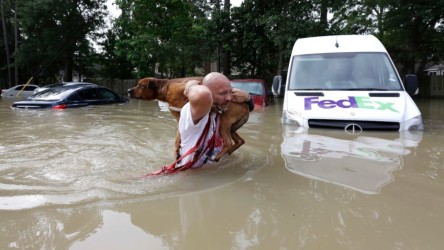
Louis Marquez carries his dog, Dallas, through floodwaters after rescuing the dog from his flooded apartment Tuesday in Houston. (AP Photo/David J. Phillip)
In the spring of this year, the news media reported floods in Texas, Oklahoma, Mexico, France, Germany, Russia, Ukraine, Australia and elsewhere.
- 9 US soldiers were lost in floods around Fort Hood in Texas.
- Other Americans have died in the flooding in Oklahoma.
- The Louve and Orsay museums in Paris are closed and moving priceless art to higher ground to protect it from the floods.
What’s going on?
Elementary chemistry.
Coal is mostly carbon, with various impurities, such as arsenic, mercury, uranium, zinc and other heavy metals. Thus, burning coal produces carbon dioxide, and oxides of arsenic, mercury, uranium, zinc, etc.
But methane, CH4, gasoline, jet fuel, are hydrocarbons. Burning methane produces two molecules of water for each molecule of carbon dioxide, as the atom of Carbon combines with a molecule of oxygen to form carbon dioxide and the two molecules of Hydrogen combine with one molecule of oxygen to produce 2 molecules of water.
CH4 + 2O2 -> CO2 + 2H2O
Similarly, Propane is C3H8. Butane is C4H10, Octane is C8H18. The general formula for the class of hydrocarbons called alkanes is CxH(2x+2). Alkenes, which have a double bond, have the formula CxH(2x). Burning hydrocarbons is, in technical parlance, “oxidizing compounds of carbon and hydrogen”. This releases energy and yields carbon dioxide and water.
According to Science Daily, here, described research by John Jones in the School of Engineering, at the University of Aberdeen, UK, who calculated that we have burned about 135 billion tonnes of oil between 1870 and 2009.
The industrial revolution has burned enough coal and hydrocarbons to increase carbon dioxide from about 280 parts per million (PPM) in 1750 to about 400 PPM today.
That’s about 800 million tons.
Think of all the oil we’ve burned, all the methane, propane, butane, octane, all the gasoline and all the jet fuel. According to John Jones at the University of Aberdeen, UK School of Engineering “we have used at least 135 billion barrels of oil since 1870” for the period ending 2009.
Jone’s academic research, “Total amounts of oil produced over the history of the industry”, was published in “International Journal of Oil Gas and Coal Technology,” 2009; 2 (2): 199 DOI: I read it online at Science Daily, here.
Millions of tons of carbon dioxide and millions of tons of water vapor.
According to American Chemical Society, ACS, Changes in greenhouse gases since the industrial revolution. and the National Oceanic and Atmospheric Administration. NOAA, “Trends in Atmospheric Carbon Dioxide,” between 1800 and 2015, atmospheric carbon dioxide increased 39.3%, from 280 parts per million, ppm, to 790 ppm while atmospheric methane increased 124% from 790 ppm to 1,770.
| Changes in Atmospheric Concentrations | |||
| 1800 | 2015 | Change | |
| CO2 | 280 | 390 | 39.29% |
| CH4 | 790 | 1770 | 124.05% |
| Table 1 | |||
As table 2 shows, in the 210 years between 1750 and 1960, 250,000 million tonnes of Carbon Dioxide were added to the atmosphere. This is an average rate of 1,190.5 million tonnes per year. in the 47 years between 1960 and 2007, another 700,000 million tonnes of CO2 was dumped into the atmosphere – at a rate of 12,127.7 mt/yr. That’s 950,000 metric tonnes of carbon dioxide.
| Atmospheric Carbon Dioxide added | ||||
| Period | Total | Rate | ||
| 1750 – 1960 | 250,000 | M Tonnes | 1,190.5 | MT / Yr |
| 1960 – 2007 | 700,000 | M Tonnes | 12,127.7 | MT / Yr |
| Table 2 | ||||
We, that is H. sapiens, have, by burning fossil fuels and via our agricultural practices, transferred into the atmosphere in the forms of methane, carbon dioxide and water carbon and hydrogen that was stored in the ground. We have also dramatically increased the amount of methane in the atmosphere. We, are now beginning to realize that this is changing the climate. We now need to figure out what to do next.
In a future post I will write about water.
–
A co-founder of Popular Logistics, I hold a BS and an MBA in “Managing for Sustainability” from Marlboro College, and over 20 years experience in Information Technology. Available as a speaker and consultant, I can be reached at “Popular Logistics . com” as “L Furman.”